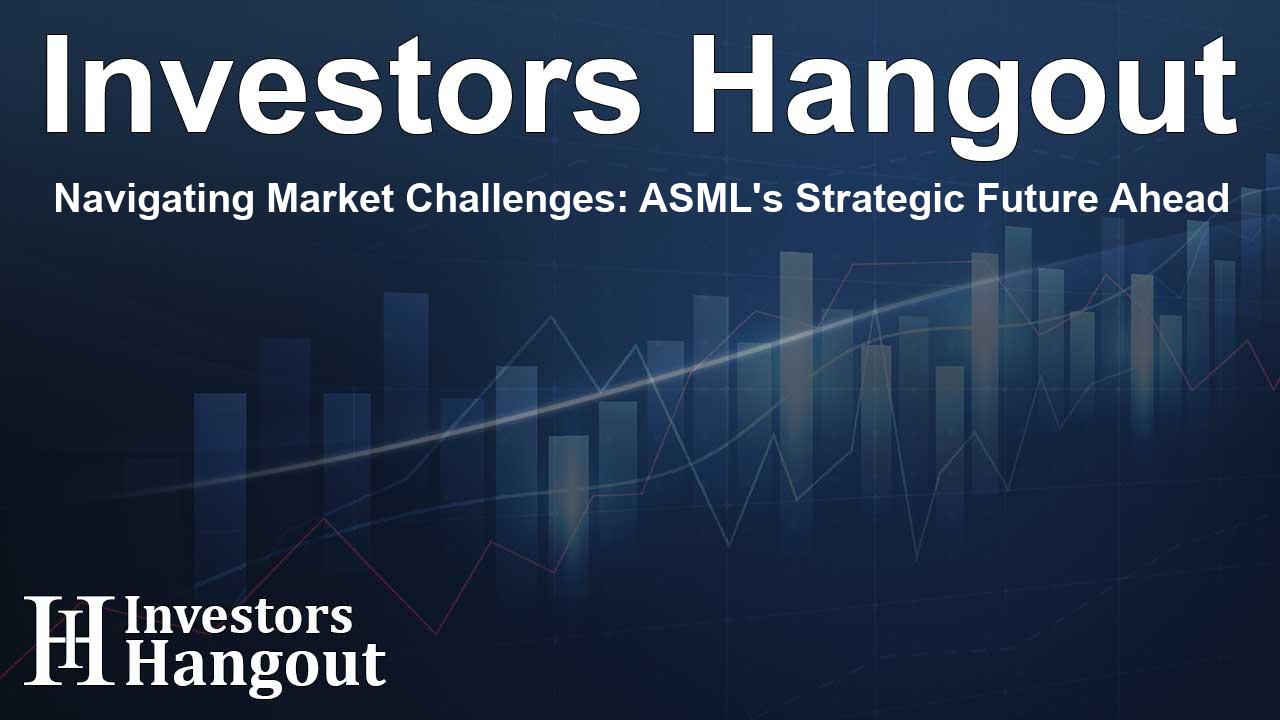Navigating Market Challenges: ASML's Strategic Future Ahead

Market Pressures and Performance of ASML
In the ever-evolving landscape of the semiconductor industry, ASML, the renowned computer chip equipment manufacturer, finds itself weathering significant challenges. The latest insights from Morgan Stanley indicate a through-line of concerns surrounding earnings estimates for ASML (AS: ASML), largely propelled by weaknesses in the memory chip market. This situation is exacerbated by rising apprehensions about demand from Chinese chipmakers and industry giant Intel (NASDAQ: INTC).
Analysts React to Current Situation
Following in the footsteps of other major brokerages like UBS and Deutsche Bank, Morgan Stanley has revised its outlook for ASML. The company’s stock price witnessed a startling 30% drop during July and August, prompting analysts to lower their earnings forecasts and share price targets. This downward trend has sent ripples of concern throughout the market, raising eyebrows among investors.
Factors Influencing Downgrades
Analysts at Morgan Stanley have highlighted several critical factors contributing to ASML's predicament. They note a dual-pressure situation from both the DRAM (dynamic random-access memory) market and Intel's shifting strategies. Moreover, there is growing uncertainty surrounding the potential overspending of semiconductor capacity in China, which may hinder growth trends as we approach 2026.
Current Stock Performance
As of the last trading session, ASML's shares fell by 2.7%, landing at 727.80 euros. This decline reflects investor sentiment swayed by recent adjustments in earnings expectations amid ongoing geopolitical uncertainties and market fluctuations.
Intel's Strategic Shifts Impacting ASML
Adding to the complexities, Intel has recently halted its expansion plans in Germany for a duration of two years. This decision comes in tandem with a major reassessment of capital spending, particularly focused on revitalizing its bespoke chip-making operations.
Interestingly, while some banks express caution, Morgan Stanley suggests that ASML is still poised for a strong performance in 2025, especially fueled by AI-connected demand for its advanced EUV tools from top-tier manufacturers like TSMC. This belief stems from historical patterns indicating that negative forecasts may be premature before a full cycle of orders hits its peak.
Concerns Regarding the China Market
Further complicating ASML's landscape are the opinions of analysts from Deutsche Bank, who have raised flags regarding ASML's business prospects in China. Notably, China's semiconductor market, which comprised nearly half of ASML's sales in the second quarter, relies heavily on the less advanced DUV product line.
Emerging Risks for ASML
Deutsche Bank’s analysts have expressed their growing concerns that the outlook for spending in China is deteriorating, highlighting the emergence of over-capacity that could stymie ASML's sales potential. Additionally, the prospect of major Chinese memory chip makers potentially being placed on the U.S. Entity List adds another layer of risk, as this action would severely restrict ASML's ability to engage in trade with these companies.
Market Outlook and Future Potential
In contrast to the cautious outlook presented by some analysts, Citi has taken a more bullish stance by labeling ASML as its top technology pick in Europe, especially following the summer sell-off. This optimistic view suggests a potential rebound driven by a healthy influx of orders expected during the upcoming earnings report scheduled for October 16.
Conclusion: Preparing for Changes Ahead
As ASML navigates the complexities of the current market, a combination of strategic recalibration, awareness of geopolitical factors, and adaptability will be critical for sustaining its competitive edge. Investors and industry watchers alike will be keenly observing how ASML responds to these challenges in the months ahead, as any strategic shifts could redefine its performance in the global semiconductor landscape.
Frequently Asked Questions
What are the main challenges ASML is currently facing?
ASML is grappling with weak demand in the memory chip market, concerns from Chinese chipmakers, and Intel's strategic shifts that impact overall market dynamics.
How has ASML's stock performed recently?
ASML's stock experienced a significant decline of 30% in July and August, with a recent drop of 2.7%, settling at about 727.80 euros.
What is driving Morgan Stanley's downgrade of ASML?
Morgan Stanley's downgrade is influenced by a combination of weakening demand in key markets and uncertainties regarding Chinese semiconductor capacity and spending.
Are there any positive outlooks for ASML?
Yes, while there are concerns, some analysts believe that ASML has a strong potential for recovery by 2025, fueled by AI-related demands for its advanced tools.
What impact do U.S. sanctions have on ASML's business?
The potential placement of Chinese memory chip makers on the U.S. Entity List could severely restrict ASML's ability to conduct trade, impacting its sales and market position.
About The Author
Contact Thomas Cooper privately here. Or send an email with ATTN: Thomas Cooper as the subject to contact@investorshangout.com.
About Investors Hangout
Investors Hangout is a leading online stock forum for financial discussion and learning, offering a wide range of free tools and resources. It draws in traders of all levels, who exchange market knowledge, investigate trading tactics, and keep an eye on industry developments in real time. Featuring financial articles, stock message boards, quotes, charts, company profiles, and live news updates. Through cooperative learning and a wealth of informational resources, it helps users from novices creating their first portfolios to experts honing their techniques. Join Investors Hangout today: https://investorshangout.com/
The content of this article is based on factual, publicly available information and does not represent legal, financial, or investment advice. Investors Hangout does not offer financial advice, and the author is not a licensed financial advisor. Consult a qualified advisor before making any financial or investment decisions based on this article. This article should not be considered advice to purchase, sell, or hold any securities or other investments. If any of the material provided here is inaccurate, please contact us for corrections.
